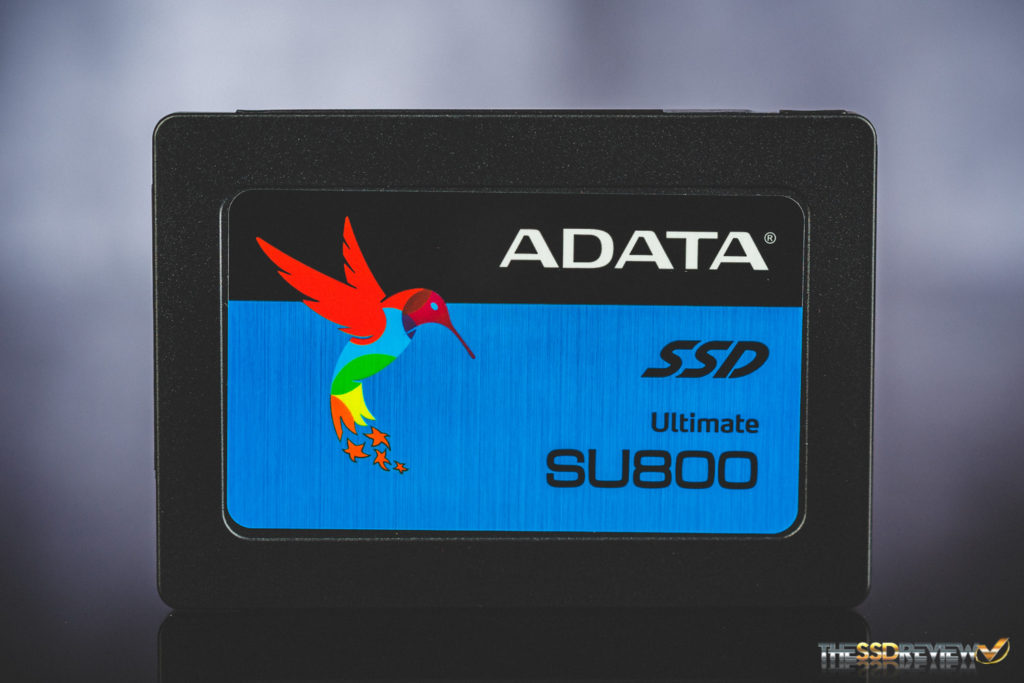The ADATA Ultimate SU800, despite the name and in contrast to the last ADATA SSD we had reviewed (SX930), is not an enthusiast oriented SSD, rather, it is an entry level/ budget SSD. The SX930 utilized a JMicron controller and enterprise-grade MLC+ NAND. The Ultimate SU800, on the other hand, utilizes a newer Silicon Motion controller and is the second SSD in the market utilizing Micron’s 3D TLC NAND. This combination of components has us charting into new waters when it comes to evaluating the performance. Initially Micron had performance issues with their MX300 and had to go back to the drawing board to improve their firmware with a Marvell controller. Could it be possible that ADATA and SMI took on the challenge that even the fab owners couldn’t handle the first time around? Or could it be a flop they need to figure out how to fix for themselves? Let’s get on with the review and find out!
SPECIFICATIONS, PRICING, AND AVAILABILITY
The ADATA Ultimate SU800 is a SATA 6Gb/s SSD that comes in a 2.5″ 7mm form factor. It is available in capacities of 128GB ($49.99), 256GB ($79.99), 512GB ($129.99), and 1TB ($269.99). It is rated for sequential read/write speeds of up to 560/520MB/s and up to 85K IOPS. The 512GB model has an endurance rating of 400TB, other models do not have specified endurance values at this time. In addition, it is covered under warranty for 3-years.
In terms of features, it supports SMART, NCQ, TRIM, and DevSleep. AES encryption is not supported. It has an SLC cache for improved write performance with the 3D TLC NAND it utilizes. The amount of SLC cache or how it works is not stated in their marketing material.
Furthermore, you can download their SSD Toolbox and it will provide you with drive info, the ability to run diagnostic scans, secure erase, update your firmware, optimize your system and more.
PACKAGING AND COMPONENTS
 The packaging for the Ultimate SU800 is quite flashy, literally. It has a reflective metallic like finish on the front. The form factor, SATA interface, and capacity are listed on the front as well as the fact that it features 3D NAND and is 512GB in capacity. On the backside, it lists the drive’s features and performance specifications and a software code as well.
The packaging for the Ultimate SU800 is quite flashy, literally. It has a reflective metallic like finish on the front. The form factor, SATA interface, and capacity are listed on the front as well as the fact that it features 3D NAND and is 512GB in capacity. On the backside, it lists the drive’s features and performance specifications and a software code as well.
Not pictured, but included with the drive is a drive spacer for backwards compatibility in thicker 9.5mm style enclosures. The black SSD shell itself is half metal, on the bottom side where the SKU sticker is and plastic on the topside where their logo sticker is. A single screw is holding the sides together under the top sticker and once removed we were able to take a look at what was inside.
In total, there are 6 NAND packages, a DRAM package, and single controller. The main feature of this drive is its 3D NAND, of which, comes from Micron. It is their latest 3D TLC, similar to that of the MX300’s. The FBGA part number on the NAND chips is NW838. This NAND is 768Gb in density and each NAND package is 96GiB in capacity. Once formatted in Windows it reads as 476GB in capacity, thus we can assume that the spare area from the raw 576GiB total will be utilized as SSD cache for the most part.
The DRAM is sourced from Nanya and is a 512MB DDR3L-1600 package. The SMI SM2258G controller is the controller of choice for this SSD. It is the same one which was used in the Intel 540S we reviewed back in May. It supports LDPC ECC, data shaping, and has a RAID engine…basically everything a modern controller should have, especially when having support for the latest planar and 3D TLC NAND. It will definitely be interesting to see how these two drives compare at the end of our review and to see just how well this Micron 3D TLC NAND can perform.
 The SSD Review The Worlds Dedicated SSD Education and Review Resource |
The SSD Review The Worlds Dedicated SSD Education and Review Resource | 

Thanks for test 🙂
Awful SSD for me, even the BX200 did better if writing much GB in a row.
wat?
its near as good as an 850 evo
Write speed drops down to 50MB/s, 850 Evo stays at over 350MB/s
850 evo drops after 3gb
this after 60gb
that means basically no client workload will see the drop 🙂
The 500GB-vesion of the 850GB stays constantly at over 350MB/s, the 1TB-version stays at 400MB/s
I will see this, I copy big files from my DVBs to the PC, over 100GB in a row, can happen 3x per session 🙂